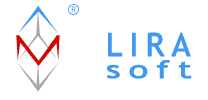 |
|
||||||||||||||||||||||||
|
|
|
Products  LIRA LIRA |
|
Solvers - methods for static and dynamic analyses for linear and nonlinear structures
LIRA contains a set of solvers and modules that realize basic analysis functions.
Linear solver realizes static and dynamic analyses of linear structures. FE method for displacements is realized. FE library includes more than 50 different types such as arbitrary bars, including elements on elastic foundation, triangular, rectangular and quadrilateral plate elements (wall-beam, shell, slab, including slab on elastic foundation); solids such as tetrahedron, parallelepiped, triangular and quadrangular prism, arbitrary convex hexagon and octagon; specific elements – spring of finite rigidity, joint compliance, out of contour element of soil foundation, etc.
Based on Linear solver in LIRA program you could follow standard routine of computer-aided design – DCF or DCL system – Design module – Sketches of drawings. Step-type nonlinear solver performs analysis of physically nonlinear bar systems, slabs and shells as well as geometrically nonlinear systems, including initially unstable systems (guys, guy trusses, tents, membranes). In this case step for determining equilibrium shape is selected automatically. For the rest of the cases the user could specify the step value. For physically nonlinear systems the stress-strain diagram is specified by the user and may be different in shape (exponential, picewise linear, etc.). It is possible to use bimaterial, for example, concrete with reinforcement bars. Based on this solver you could simulate 3D procedure of loading the structure. E.g. for reinforced concrete slab you could trace crack propagation process, plastic strain in compressed concrete and tensile reinforcement, obtain stress-strain state that causes the fracture. With this solver you could also analyse the structure taking account of physical and geometrical nonlinearity simultaneously. Nonlinear iteration solver analyses systems with one-way restraints as well as physically nonlinear plate (plane stress, plane strain) and massive systems for material with diagram σ-ɛ (or P-∆) in the shape of Prandtl diagram. This solver enables you to perform analysis with different loading and unloading paths, that is, in elasto-plastic statement. Combined nonlinear solver analyses different combined systems. For example, physically nonlinear reinforced concrete slab on nonlinear soil foundation, or physically nonlinear reinforced concrete sheet piling (strengthened with anchors) together with retained nonlinear soil of foundation pit, etc. FE library of nonlinear solvers contains bars, cable elements, plate elements (triangular, rectangular, quadrilateral), solids (tetrahedron, parallelepiped, prism, convex hexagon and octagon), specific elements. Specific finite elements include e.g. turnbuckle that simulates the tensioning process for guy meshes, membranes, anchors of sheet piling. This element enables the user to trace the tension and its slackening up to the moment when the structure reaches specified tension or gains equilibrium shape. Based on Nonlinear solver in LIRA program you could follow standard routine of computer-aided design – DCL system – Design module – Sketches of drawings. Back to LIRA |
